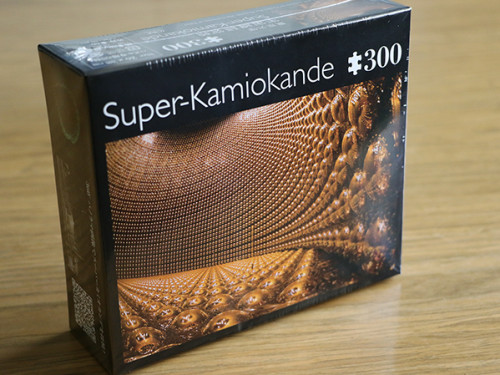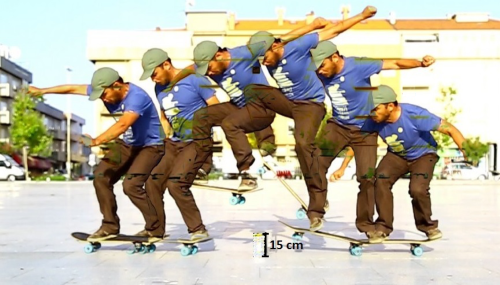Tag archives: mechanics
A puzzling neutrino detector, the best way to crumple cans

Standard model: Super Kamiokande jigsaw puzzle (Courtesy: ICRR)
By Michael Banks
If you are looking for a Christmas present for a puzzle lover, the Institute for Cosmic Ray Research (ICRR) in Tokyo, Japan, has just the thing. It’s created a 300-piece jigsaw puzzle of the Super Kamiokande neutrino detecter in Kamioka, Japan. The detector is a giant stainless-steel tank filled with 50, 000 tonnes of ultra-pure water and lined with 13,000 photo-multiplier tubes that detect the Cherenkov radiation released when a neutrino collides with a water molecule. In other words, it’s a jigsaw puzzle featuring water and lots and lots of identical tubes.
Costing ¥1500 (£10) and with a finished size of 38 x 26 cm, a limited number of the jigsaws went on sale in late October. But its fiendish nature doesn’t seem to have put anyone off: the puzzle sold out within days. Jigsaw enthusiasts, however, will be pleased to know that, as, the ICRR is planning to release more. (more…)
View all posts by this author | View this author's profile
The physics of sperm: the movie
By James Dacey
Luke Skywalker et al. re-entered the public imagination recently with the release of the trailer for Star Wars: the Last Jedi. But where that movie takes you on a galactic adventure, a new short web film by the Wyss Institute in the US takes you on a swashbuckling tour of the microscopic – tracking animated sperm on a mission to fertilize an egg.
The Beginning is based on collaborative work between a pair of researchers at the Wyss Institute for Biologically Inspired Engineering at Harvard University. Founding director Don Ingber teamed up with the biophysicist/professional animator Charles Reilly to seek an atomic-level understanding of sperm movement. Combining molecular dynamics simulations with film animation software, they have visualized how a sperm tail moves based on scientific data.
View all posts by this author | View this author's profile
Reminiscing about Fermilab, CAPTCHA tests your physics, science of guitar strings
By Hamish Johnston
What do huge snowstorms, pioneering childcare and bison have in common? The answer is that they all feature in video recollections of Fermilab, the particle physics facility that is celebrating its 50th anniversary this year. A playlist of the videos is available and you can watch Cindy Joe’s musings over Snowpocalypse 2011 above.
According to physics blogger ZapperZ, the online retailer Amazon is developing a new CAPTCHA technology that relies on human’s innate understanding of the laws of physics. The idea, apparently, is that a user would be presented with before and after scenarios and asked which seem plausible. This could be a ball rolling down a ramp, or a projectile flying through the air. It seems that web robots can’t solve simple mechanics problems – at least for now.
Ending on a bright note, music technologist and erstwhile physicist Jonathan Kemp of the University of St Andrew’s in Scotland claims to have invented a revolutionary type of guitar string. He riffs on his new creation in the video above.
View all posts by this author | View this author's profile
Testing the brain’s “physics engine”, lawnmower aurora alert and more
By Hamish Johnston and Tushna Commissariat
You may not know it, but apparently you have a dedicated region in your brain that is your “physics engine”. At least that is what cognitive researchers from Johns Hopkins University are suggesting after they have pinpointed a specific region of the human brain that intuitively understands physics – at least when it comes to predicting how objects behave in the real world. According to the team, the engine is kick-started when we observe physical events as they happen and is “among the most important aspects of cognition for survival”. Surprisingly, the region is not located in the brain’s vision centre, but is actually the same area we tap into while making plans of any type. In the video above, the team has created a little game for you to test your engine’s horsepower – go ahead and tell us how you did.
View all posts by this author | View this author's profile
Skateboard videos reveal the physics of doing an ‘ollie’

Free-body problem: how do skateboarders do an “ollie”? (Courtesy: Paulo Simeão Carvalho/Physics Education)
By Hamish Johnston
Here’s a problem for keen students of classical mechanics: how can a skateboarder cause their board to leap into the air by pressing down on it with their feet?
What I’ve described is a trick called the “ollie”, which first emerged on the skateboarding scene in the late 1970s and is now an essential part of the skating repertoire. There’s a fascinating paper in the journal Physics Education, which shows how digital videos of people doing an ollie can be analysed to get to grips with the physics underlying the trick.
The above image shows six video frames of someone executing an ollie – with time moving from right to left over a period of about 2 s. If you delve into the paper, you will find out how its authors – Marco Adriano Dias, Paulo Simeão Carvalho and Deise Miranda Vianna – used video images to track the motion of the tail of the board as well as its front and back wheels. This was then compared to a free-body diagram analysis of the forces of the board.
View all posts by this author | View this author's profile
Balancing bicycles, looking back on Trinity, pricing up Pluto and more
By Tushna Commissariat
Mechanics was never my favourite topic when I was studying physics for my BSc, but I think I might have been more interested if we had looked at real-world situations rather than square blocks sliding down an incline plane. A bicycle that carries on, sans rider, without toppling over for quite a long time, for example, would have got my attention. This is a rather well-known quirk of mechanics though and it isn’t even the first time we have discussed it on the blog. Indeed, Physics World‘s James Dacey, a keen cyclist, delved into the topic in 2011. This week, we spotted a a new Minute Physics video on the subject, over at ZapperZ’s Physics and Physicists blog. Watch the video to get a good, if a tiny bit rushed, explanation of the three forces that come into play to allow a bicycle at a certain speed to zip along without its human companion. As the video suggests, all is not known about the secrets of free-wheeling bicycles just yet though, and I have a feeling that we will blog about it again in the years to come.
View all posts by this author | View this author's profile
The trebuchet challenge, the physics of ketchup bottles plus sage advice for budding science-fiction writers
By Hamish Johnston
“A surprising amount of stuff gets wasted every year because consumers can’t get it out of the packaging it came in,” writes Katie Palmer, who covers the science beat at Wired. In her article “The physics behind those no-stick ketchup and mayo bottles”, she explains how the company LiquiGlide has developed its slippery coating for the insides of bottles. The challenge was to create a permanently wet coating that would stick to the inside of the bottle but not mix with the liquid foodstuff – and it also has to be safe for human consumption.
LiquiGlide spun out of the lab of Kripa Varanasi at the Massachusetts Institute of Technology and has just announced that an international food-packaging supplier will be using the coating on its mayonnaise bottles. You can watch a demonstration of the coating in the video above.
View all posts by this author | View this author's profile
Villainous physicists, Hubble’s cat and more

Eddie Redmayne as Stephen Hawking in the film The Theory of Everything. (Courtesy: Universal Pictures International)
By Tushna Commissariat
This week we heard about a possible new James Bond film villain and its none other than Stephen Hawking. According to this story in the Telegraph, he feels as if his trademark wheelchair and computerized voice would lend themselves perfectly to the part. On the same note, we saw this interesting feature on the Wired website that looks at the history behind Hawking’s very recognisable voice. Last month, I was lucky enough to attend an early screening of James Marsh’s Hawking biopic The Theory of Everything, which includes a rather touching and funny scene of Hawking testing out his voice for the first time. You can read more about the film in the reviews section of the upcoming January issue of Physics World.
View all posts by this author | View this author's profile
Blockbuster physics, bowling balls and feathers in a vacuum, and more
By Tushna Commissariat
The results of a successful scientific experiment can make scientists very happy. Indeed, in the clip above, taken from the BBC TV series Human Universe, one scientist exclaims “holy mackarel!” when he sees the outcome he was hoping for. In the video, everybody’s favourite physicist Brian Cox carries out an experiment similar to Galileo’s Leaning Tower of Pisa experiment, where he tested that no matter the mass of objects, they fall at the same rate under gravity. In the video above, Cox drops a bunch of feathers and a bowling ball in the world’s biggest vacuum chamber – the Space Simulation Vacuum Chamber at NASA’s Space Power Facility in Ohio, US. In the slow-motion video, you can see with exquisite clarity just how accurate Galileo’s prediction was, as the feathers and ball land at precisely the same time. We came across this video on the Dot Physics blog on the Wired Science network, written by physicist Rhett Allain, where he has worked out some of the maths and pointed out some of the nuances of the above experiment, so make sure you take a look.
Earth’s cousin, alien intelligence, Galileo’s game and more

Artist’s illustration of Kepler-186f. (Courtesy: NASA/SETI Institute/JPL-Caltech)
By Tushna Commissariat
Early last week, astronomers announced that they had found the first Earth-sized exoplanet that is comfortably within the habitable zone of its parent star, using NASA’s Kepler telescope. The new planet, dubbed Kepler-186f, is a close cousin of the Earth as it has a radius that is only 10% larger than that of the Earth, meaning that it could have liquid water on its surface, allowing for the tantalizing possibility of some form of life to exist upon it. At last count, Kepler has now discovered and confirmed 1706 exoplanets.
So it was rather interesting to come across two stories that looked at the implications of life beyond our planetary neighbourhood. Paul Gilster, who writes the Centauri Dreams blog had a rather interesting post on how artists and illustrators need to work with scientists to depict each new exoplanet, to make the images look visually stunning, while still being scientifically accurate. Gilster also talks specifically about the image (see above) that illustrates the newly found Kepler-186f.
View all posts by this author | View this author's profile